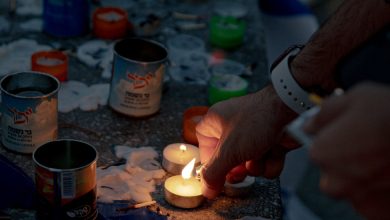Trayvon Martin Is Still Making America Confront Its Original Sin

Supported by
Continue reading the main story
Trayvon Martin Is Still Making America Confront Its Original Sin
- Read in app

By Charles M. Blow
“One of the most important things that came out of this tragedy was the activation of an entire new generation of civil rights leaders.” That was part of what President Barack Obama told The Times when we asked him what the killing of Trayvon Martin, 10 years ago Saturday, meant for the United States, the movement for civil rights and for him personally.
On Feb. 26, 2012, a 28-year-old neighborhood watch captain, George Zimmerman, spotted Martin in a hoodie walking through a gated townhouse community not far from Orlando.
Suspicious, Zimmerman called 911 and followed Martin. Dispatch told him, “We don’t need you to do that.” There was an encounter between the two before Zimmerman shot Martin in the chest at close range.
Martin was just 17 years old, a boy, and he was where he was supposed to be.
He was unarmed. He was carrying Skittles and a can of iced tea.
There was something about the killing of this particular boy that set it apart from all other killings of Black people, that struck a chord in Black America, that awakened a generation.
Jesse Jackson once called the 1955 lynching of Emmett Till, the 14-year-old Chicago boy brutally murdered in Mississippi, the Big Bang of the civil rights movement. In the same way, the killing of Trayvon Martin was the Big Bang of the new civil rights movement, Black Lives Matter.
The #BlackLivesMatter hashtag would be born only after Zimmerman was acquitted of murder. But the movement itself started after the killing.
Zimmerman had been questioned by the police but was released without any charges. Nearly three weeks later, with Zimmerman still free, I wrote a column to help elevate the case, articulate the pain of this family and illuminate the oddities of how the case had been handled. It was published on a Friday. The following Wednesday, activists organized the Million Hoodie March in New York City. Two days later, President Obama famously said, “If I had a son, he’d look like Trayvon.”
When I interviewed Sybrina Fulton, Martin’s mother, in Miami the following day, she was a broken woman, still trying to comprehend the incomprehensible, trying to fight for her son, trying not to lose herself. But it was clear to me that the president had now helped to set the boy on two tracks: He had belonged to Fulton, most assuredly, but he would now also belong to the world, as archetype and icon of Black victimization in a society hostile to blackness. His killing would epitomize a collective trauma.
The president’s comments also made Martin a proxy for Obama. Attacking and discrediting boys like Martin became a roundabout way of attacking and discrediting the president. Martin would become not only an anchor for activism, but also an object for political acrimony.
Not every killing connects with the culture and activates a mass movement. In fact, few do. It’s exceedingly rare. But maybe once in a generation, maybe once in a century, one lands like a match on dry kindling.
Martin’s killing did just that.
The air itself, at the time, was crackling with revolt. The Arab Spring had just swept the Arab world as young people rebelled against oppression, authoritarianism and stagnation. And in the United States, Occupy Wall Street, an overwhelmingly white movement, was changing the narrative of economics and wealth, by spotlighting social and income inequality. Young people everywhere were flexing their muscles with surprising strength. And young Black people in particular were coming of age in an era of social media, watching the rise of Black Twitter with its activist instinct, learning about intersectionality, the idea that multiple forms of oppression can and do overlap like a Venn diagram, and reading Michelle Alexander’s wildly successful “The New Jim Crow.”
A new racial consciousness was awakening, and to be fully conscious of American racism is to be fully enraged by it.
Martin’s killing, like Till’s, was a catalyst, their images became iconography, and their lives became legend.
Though different in many ways, both killings transformed our culture, as young Black people with pent-up energy came to identify with the victims.
As Timothy B. Tyson put it in his book, “The Blood of Emmett Till,” the “lynching became a decisive moment in the development of their consciousness around race.”
Rosa Parks was much older than Till when he was lynched — she was 42 — but even she said that she was thinking of him when she refused to give up her seat to a white passenger on a Montgomery bus later that year, sparking the historic bus boycott.
The same can be said of the killing of Martin.
Obama was 50 when Trayvon died, but as he told The Times, he, too, saw himself in the teenager. He still believes “that maybe the only thing that separated us was luck and the fact that I was living in a place, in Hawaii, where the likelihood of a gun floating around or a private citizen stopping me on the street was a lot lower.”
That sense of kinship and identification was what transformed the killing into a movement. As the Harvard historian Henry Louis Gates Jr. put it, “every bit of progress on the issue of justice in policing, all the way to George Floyd,” can be traced back to that killing. The civil rights activist and cable news host, the Rev. Al Sharpton, called it an “awakening.”

Credit…Aaron Marin
During both civil rights movements, the outrage shifted quickly from the actions of individuals to the indictments of systems, as activists sought not just justice for the victims but fundamental changes to the laws that prevent progress, the politicians who crafted them, the attorneys who employed them and the judges who interpreted them.
As Martin Luther King would often say:
“It may be true that morality cannot be legislated, but behavior can be regulated. It may be true that the law cannot change the heart, but it can restrain the heartless. It may be true that the law cannot make a man love me, religion and education will have to do that, but it can restrain him from lynching me.”
The climax of civil rights movement as a protest movement came with the 1963 March on Washington for Jobs and Freedom. By then, the movement was much larger than Till. It took place on the eighth anniversary of his lynching, but none of the main speakers mentioned his name. And within a decade, the movement had succeeded in passing the Voting Rights Act of 1965 and the Civil Rights Act of 1968, which included the Fair Housing Act.
The ultimate policy victories of Black Lives Matter are not yet known. On the federal level, the George Floyd Justice in Policing Act, which passed in the House, died in the Senate. But the movement has had much more success on the city and state level.
In 2020 and early 2021 alone, more than 30 states passed at least 140 new police oversight and reform laws. In total, seven states have mandated the use of body cameras, five states have limited qualified immunity for officers (Colorado and New Mexico eliminated it), and at least 24 states have passed legislation restricting neck restraints.
Even before 2020, there were nationwide pushes for the use of body cameras by officers and to have cameras installed and operational on their vehicles.
Black Lives Matter has also experienced a backlash. Resentments always bubble to the surface when a movement experiences some success, and racists rise up to repel its advances. But that’s not what I’m talking about. The backlash that always feels like betrayal is the shifting of allegiances among supposed allies, the people who are with you only up to a point, the point at which your liberation threatens their privilege.
The same dynamic played out during the civil rights movement. A New York Times survey, conducted in the months following the passage of the Civil Rights Act in 1964, found that a majority of white New Yorkers, a supposedly liberal bastion, “believed the Negro civil rights movement had gone too far.” Some of the respondents spoke of Black people getting “everything on a silver platter” and of “reverse discrimination” against white people.
When the Kerner Commission released its 1968 report pointing out inequality, highlighting the pernicious nature of police brutality and pushing the Johnson administration to invest heavily in improving Black people’s living conditions, Congress refused to act on any of those recommendations. Nor did it advance police reform alongside socioeconomic improvement, as the Black community wanted. Instead, as the Marshall Project’s Nicole Lewis has written, “the federal government responded by equipping police with new tools to control violent expressions of civil unrest.”
Today, Democrats are once again shrinking from — or, in some cases, running from — police reform in the face of rising violent crime data, worried about being labeled “soft on crime,” or worse, a defund-the-police pusher.
And that’s only part of the backlash. Elsewhere, conservatives have made inroads in swing districts by stoking the Critical Race Theory panic, which is an attack on history and the teaching of it. Republican lawmakers have also sought to clamp down on peaceful protests. According to the International Center for Not-For-Profit Law, since 2017, 45 states have considered 245 bills that would restrict the right to peaceful assembly. Thirty-six of those bills passed. Some of them would protect drivers who hit protesters with their cars on public streets.
It is too early to know precisely where we are in the life of Black Lives Matter as a national movement, whether it’s waning or still vibrant and viable; no movement lasts forever. But there is no denying that the movement changed this country, and it all started with the tragic killing of a Florida teenager.
As President Obama put it, “My hope is that when we look back at what happened with Trayvon and are able to say that that was the start of America looking inward, and, in fits and starts, coming to terms with what was our original sin.”
Jonah M. Kessel (@jonah_kessel) is the deputy director of Opinion Video. Quincy G. Ledbetter is a filmmaker. Adam B. Ellick (@aellick) is the executive producer of Opinion Video.
The Times is committed to publishing a diversity of letters to the editor. We’d like to hear what you think about this or any of our articles. Here are some tips. And here’s our email: [email protected].
Follow The New York Times Opinion section on Facebook and Twitter (@NYTopinion), and Instagram.





